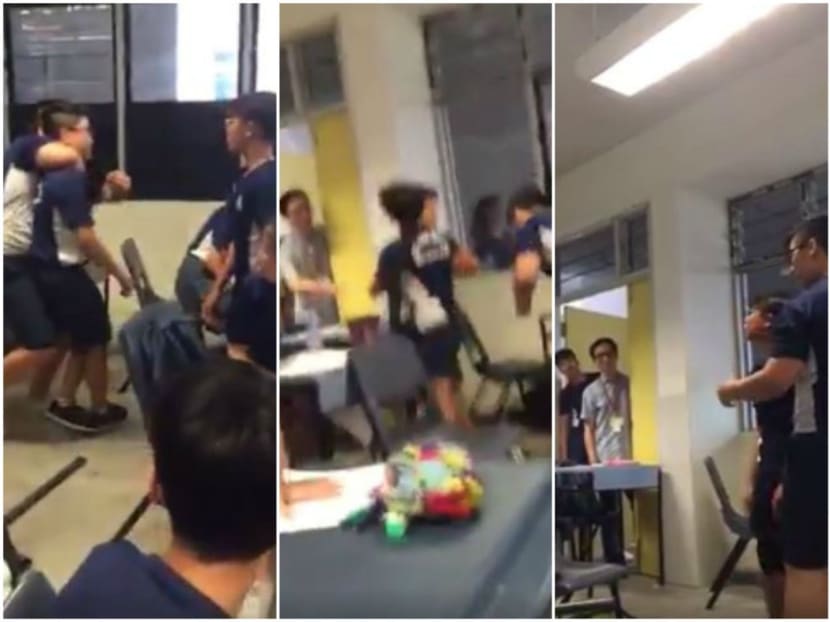'Very few' bullying cases in schools, minister says, despite recent online clips
SINGAPORE — The number of bullying cases in schools here have been “relatively stable”, Minister for Education (Schools) Ng Chee Meng said in Parliament on Tuesday (Oct 3).

Last month, a video clip of a classroom brawl involving three students at St Hilda’s Secondary School was widely circulated online. The school said that it was counselling and disciplining the students involved in the fight in class. Still image taken from video
SINGAPORE — The number of bullying cases in schools here has been “relatively stable”, Minister for Education (Schools) Ng Chee Meng said in Parliament on Tuesday (Oct 3).
For 15-year-olds, for example, about 10 per cent experienced some form of social bullying (being purposely left out by others) and 20 per cent were subjected to verbal bullying. Physical bullying was less prevalent at about 5 per cent, Mr Ng said, citing findings from a 2015 Organisation for Economic Cooperation and Development (OECD) student perception survey.
These figures are quite similar to findings by the Ministry of Education (MOE) and those from other studies done here, he said.
“MOE does not tolerate bullying in any form and every child has a right to feel safe and secure in our schools,” he added.
Mr Ng was responding to a question from Associate Professor Daniel Goh, Non-Constituency Member of Parliament, who asked about the prevalence of bullying in schools, the preventive measures that are taken, whether teachers are trained to handle such incidents, and if students involved are given counselling care.
On Assoc Prof Goh’s other question on the growing number of videos of school bullying posted online, Mr Ng said that such video postings and filming of the cases were done through mobile phones, which are prohibited in schools.
More important, he said, is the “upstream measures”, such as teaching students how to cope with bullying behaviours and taking positive action to deal with those negative behaviours.
“Generally, our students are well-behaved. Incidents in our schools, in terms of bullying, are very few and have been relatively stable,” he added.
Last month, a video clip of a classroom brawl involving three students at St Hilda’s Secondary School was widely circulated online. The school said that it was counselling and disciplining the students involved in the fight in class.
Mr Ng said that when students misbehave or make mistakes, they would be disciplined and educated by the schools to prevent a repeat of such incidents. School staff members will also counsel those who are involved in bullying and those affected by the incident.
School personnel have been trained to give attention to and address hurtful behaviours. Teachers get training in classroom management strategies and fostering positive classroom culture, for example.
For the students, they learn social skills, empathy, respect and awareness of the effects of mean actions on others through the Character and Citizenship Education module. “They also learn coping strategies, relationship management and help-seeking skills. Schools also actively create a positive and supportive environment for all our students,” he added.
Student peer supporters are taught to befriend and lend a listening ear to other students, and they will alert and get help from teachers when they observe situations that may affect their classmates’ safety.
Asked by Nominated Member of Parliament Chia Yong Yong how cyber bullying cases are identified, Mr Ng said that cyber bullying is a growing area of concern that schools are dealing with, where an online post can be seen by many and reposted, causing hurt to the victims.
Schools have also been providing accessible channels for support, where pupils can report bullying cases, and staff members can investigate and follow up promptly on these, he added.
There are different avenues for students to report such cases, but Mr Ng noted that the best way to deal with it is through the network of peers, teachers and counsellors in schools. While he does not have figures on the cases reported through phone help-lines, he reiterated that on the whole, bullying has been “stable and managed”.
Depending on how severe is the bullying case, the student’s parents could be notified to take part in post-incident counselling, look at how the issue has been dealt with, the follow-up action to be taken, among other things, he explained.









